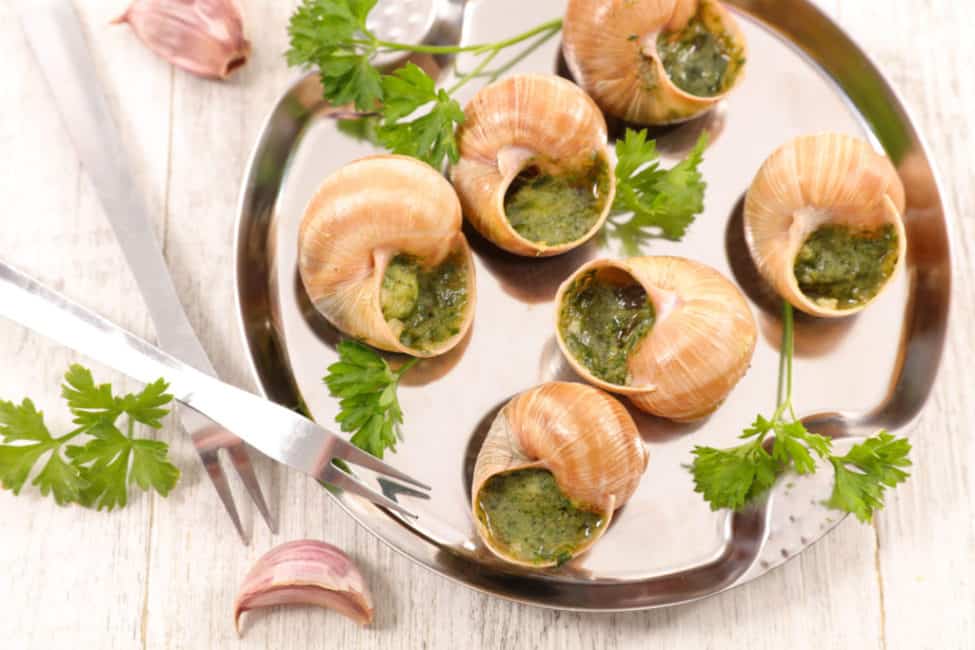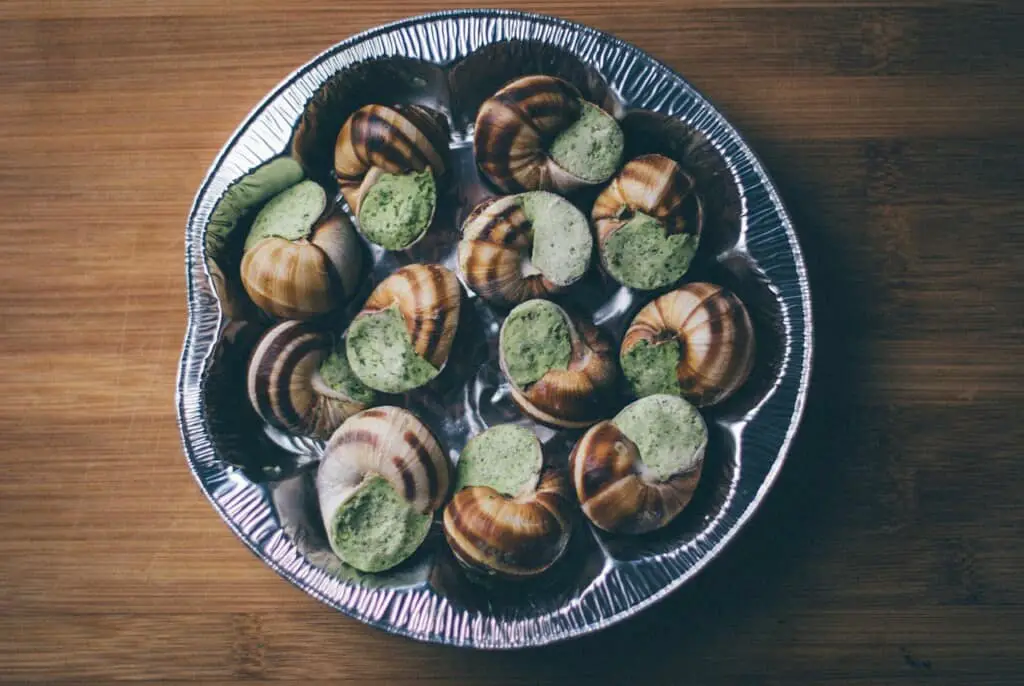Escargot is an unknown dish to many. But those who have tasted this French delicacy understand how delicious the Helix pomatia snail can be when prepared professionally. But what does escargot taste like?
Escargot’s texture resembles those of clams and are often said to taste like fish or chicken, with an earthiness reminiscent of mushrooms. However, the snails tend to take on the flavor of the escargot sauce with which it is cooked.
With 16,000 tonnes of snails (about 480 million) eaten annually in France alone, the dish of escargot isn’t a passing fancy. In this article, we’ll talk about what escargot tastes like, why and how people eat snails, how it’s prepared, and whether or not escargot is good for you.
Table of Contents
What is Escargot?

The word escargot is the French word for snail. Escargot is a dish that is cooked using any of several species of snails.
The dish is most commonly served in French restaurants but can be found in many parts of the world and in many different types of cuisine.
According to research carried out by PLOS One, people have been eating land snails for the last 30,000 years.
While, to some, escargot might just be a tradition that’s been passed down through generations, it is also associated with “premium” dining and high social class in some places, which may be why the meal is often pricey.
Whether you’re planning a trip to France and want to get the full experience, or you just want to try new foods, let’s talk about the taste of escargot.
What Does Escargot Taste Like?
A question that is often asked, given the physical appearance of the plated snails, is if escargot tastes like mussels or clams. The meals look similar and are prepared almost the same, which makes people expect that they will taste the same as well.
However, cooked snails tend to take on the taste of the sauces used to prepare them. The most common escargot recipes include garlic, butter, and wine or vinegar.
To soak up all the goodness of the rich sauces that accompany escargot, the meal is often served with slices of bread.
The biggest reason people don’t like escargot is because of the texture, it will have a chewy texture and if cooked incorrectly it could have a rubbery texture.
But, this preference will vary by person so you’ll just have to try it and find out.
Do you Chew Escargot?
Escargot, like any other seafood, should be chewed. The snails are firm and meaty, which may seem surprising since their physical appearance makes them look soft and slimy.
However, when eating this meal for the first time, some people prefer swallowing a little fork-full of escargot without chewing because they expect the snails to be slimy.
While swallowing without chewing may seem like an easy way to get them down, this method doesn’t allow a diner to experience the complete taste of the escargot. Plus, you wouldn’t want to risk choking on it.
5 Healthy Reasons to Eat Escargot
There are several characteristics of snails that make snails a healthy meat to eat. Here’s a quick run-down of some of the health benefits of snails:
1. Low-Fat Content
Because the snail eaten as escargot is basically one single muscle inside a shell, there isn’t much fat on it. This combined with the other nutritional benefits makes them a good healthy addition to a meal.
2. Minimal Carbs
Most of the carbs found in an escargot dish will come from the sauce they are cooked in. This is because escargot is pretty much all protein which doesn’t leave any space for extra carbs.
3. Excellent Source of Protein
One 4-oz serving of snail meat contains 18 grams of protein. That’s a lot of protein-packed in those little snails!
This combined with the fact that they have low fat and aren’t carb heavy makes them an excellent meal choice.
4. Less Commonly an Allergen
Snails are not as common of an allergen as many other seafoods such as shrimp and lobster. However, escargot is in the shellfish family, so if you have a shellfish allergy please don’t try escargot.
5. Other Nutritional Benefits
According to nutritional data, depending on how you cook them, snails are an excellent source of Vitamin E, Zinc, Calcium, and Iron.
Snails are also high in tryptophan, a chemical that releases serotonin that is responsible for regulating our moods. With no sugar and a tiny amount of carbohydrates, escargot is a perfect meal that contains little calories. A 3-ounce serving of escargot contains only 76 calories.
How to Prepare Escargot

If you’re a hands-on kind of person and would like to prepare escargot in your kitchen, the following steps will come in handy. If you’re the restaurant type, you may still find this interesting, so you know what the chef is doing behind the scenes.
It’s not as complicated a procedure as you might think, and with a little help, you can serve escargot to your friends or family in no time. Let’s talk about choosing the snails first.
The snails are cooked while they are alive. They are first rinsed in saltwater to remove their slime. The rule of thumb is to never cook a dead snail. If you suspect the snail is not moving, try to poke it to provoke a reaction. If there is no movement, don’t attempt to cook the snail.
What You Need To Know About Fresh Snails
You may think it is preferable to cook freshly caught snails, but this isn’t the case.
The majority of a snail’s diet doesn’t agree with the human digestive system. That is why most chefs will starve their snails before preparing, to allow for any toxins to be eliminated from the snails.
So, it’s best to ask the seller when the snails were caught, which might give you a rough estimate of when they last ate and when you can prepare them.
The general rule of thumb is that it is safe to consume snails that were harvested a week before you bought them.
Experts have recommended “purging” snails or feeding these snails with food that agrees with the human digestive tract, such as pieces of apple or grape leaves, which helps to eliminate the toxic substance within them.
How to Clean the Snails
Before cooking, you should adhere strictly to effective snail-cleaning steps. This way, the meal will not be irritating and can be consumed easily. The entire cleaning process is not for the faint-hearted or people with delicate stomachs.
Around 50 snails will suffice for a meal of 12 people. The more snails, the better.
- Place the snails inside a pot with a mixture of salt, water, and vinegar to help remove their waste. This step is preferred if you have bought the snails right from the boat or have harvested them yourself.
- Remove the membrane covering the shell opening with a sharp knife.
- Fill a pot with fresh water and put the snails in the pot.
- Discard any snails that float to the top of the pot.
- Using your fingers, rub two to three snails at a time and work your way through the batch.
- After cleaning the entire batch, throw away the water and refill the pot with fresh water. Repeat the rubbing step.
- Rinse the snails completely.
After you have cleaned the snails, it’s time to move on to the ingredients. Depending on the taste you want for the snails, there are different ingredients that you can use. Here we’ll use a recipe for a garlic sauce.
Ingredients
- Snails
- 1 peeled and separated head of garlic
- 12 slices of baguette
- ½ cup of white wine (110 ml)
- Salt and pepper
- 1 thinly sliced shallot
- 4 ounces of butter (112 g)
- 1 ounce of fresh parsley leaves
Cooking Instructions
Combine the white wine, shallot, and snails in a small sauté pan and bring it to simmer. After cooking for 15 minutes, drain the snails and set them apart.
Combine parsley and garlic inside the food processor or blender until they are finely chopped. Add butter to the mixture and process. The result should be a green, smooth paste. For taste, make sure you season with pepper and salt.
If you have reserved the snail shells, place the snails back into them. Then use the parsley butter to stuff the remaining spaces in the shells.
Put the snails inside the baking dish and into a preheated oven to broil. Wait until the butter is sizzling. The escargot is ready to be served with the bread.
If you don’t have the snail shells: put the baguette slices lined in a sauté pan. Add butter and place the pan over high heat. After the butter has liquefied, add the snails, and let it sizzle. Serve immediately.
The only thing left to do is to get your tiny fork out and dig in, enjoy!
Related Questions
What Does Halibut Taste Like?
Halibut is an extremely light and flaky fish. It is known for its un-fish-like taste. If you don’t usually like fish because of the fishy taste, then halibut is an excellent fish to try. For more details about halibut and what it tastes like, check out this post: What Does Halibut Taste Like? Amazing Ocean Eats.
